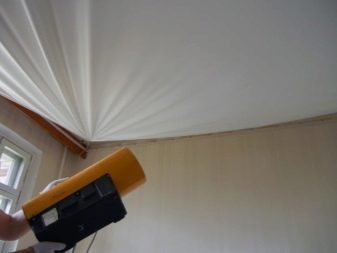Why does the stretch ceiling sag?

Stretch ceilings are made on the basis of film raw materials and high-strength vinyl. It is distinguished by its low weight, thinness of the canvas, and allows you to carry out ideas of any complexity. Despite the increased strength of the film, many face various problems after installing a new ceiling. One of them is the sagging of the canvas.
Determine the reasons
If the ceiling sags by 1% after installation, this fact is not a defect. In this case, it should be remembered that it cannot be perfectly flat due to the effect of its own weight on the canvas. The larger the area of the room, the greater the differences between the levels. If the area of the blade is small, the tension will be less noticeable.
Initially, you need to thoroughly think over all theoretically possible problems that may arise after installing the ceiling. A competent approach to business will avoid costly installation, and will also save your time.



There are a few major errors most commonly encountered during installation. Let's consider the main ones:
Incorrect installation
It is necessary to check how tightly the baguette adheres to the wall. Perhaps this is the problem. If the ceiling area is relatively small, a 2 cm gap is enough to make the ceiling sag. Such a case may arise due to improper installation or the use of an inappropriate material for the wall.
Often, due to the negligent attitude of the craftsmen to the quality of the work, the dowels may not firmly sit in the loose base of the wall. The solution is to use longer dowels or find a solid section of the wall.
Sagging is often caused by pieces of plaster falling from a flimsy wall onto a stretch canvas... To solve the above problem, you need to contact a specialist. In this situation, you cannot do without dismantling. To remove fragments of plaster, you need to remove part of the film or the entire canvas. There is no other way to solve this problem.


Insecure baguette attachment
It is important to remember about strengthening the frame of the structure at the level of fastening the baguette, if the ceiling installation is done to a plasterboard box. Stretch ceiling acts on drywall sheets, resulting in sheet breakage or partial tearing off the surface.
Do not attach the material to a base that can cause breakage.


Poor foundation preparation
Often, customers are faced with unfair foundation preparation. The stretch ceiling hides irregularities, but this does not mean at all that the surface does not need to be cleaned of bumps and plaster residues.
In addition to leveling, it is necessary to strengthen the surface with a primer. If this is not done, over time, pieces of plaster will fall on the stretch ceiling canvas.



Flooding
If you live in a multi-level house, the cause of the sagging can be a banal water leak. Run your palm across the ceiling: if you feel heaviness and rolling water close at hand, the problem is a leak. Water can form a bump or bubble. In this case, the sagging of the ceiling is visible to the naked eye.
Do not try to pierce the bubble, smooth it out with improvised means, distill water under the canvas in the direction of the hole for the lamp.
The size of the bubble depends on the density of the material.



You can try to solve the problem yourself. De-energize the living area. Remove the light and try to estimate the volume of the liquid by looking inside the ceiling. Use a stepladder or stable support. If there is too much liquid, use a hose. Pass one end of the hose under the canvas, lower the other end into the prepared container.
Self-draining of water does not guarantee the return of the ceiling to its original flawless appearance. (the exception is fabric light-transmitting ceiling). Do not try to smooth out the wrinkles that have formed. It will not be possible to cope here on your own: you will have to invite specialists. The correct solution is to warm up the ceiling with a heat gun.that is used for initial installation.




Differential pressure and lack of tightness
If you live in a private house, the ceiling may sag and become smooth over time. This is due to pressure differences. The canvas can swell from the constant flow of air, which, for example, can come from an open window.
It must be remembered that air must not circulate between the main ceiling and the panel.

Exposure to temperature
Most manufacturers claim that the stretch ceiling is not subject to deformation due to temperature changes. Unfortunately, this is not always the case. If the temperature in the room rises sharply, this can cause serious deformation of the material. For example, it can stretch over the entire area, which will require dismantling over time.
A noticeable drop in temperature has no significant effect. However, constant low temperature can lead to shrinkage and film and cracking.


If there is a problem with lowering the ceiling, there are several ways out of an unpleasant situation.
Warranty case
The guarantee only works when you have wisely approached the choice of a contractor. Reputable organizations must sign an agreement with you, which stipulates all warranty repair cases. Sagging of the ceiling is a fairly common occurrence that the company must address at its own expense.... This way out of the situation with the sagging of the stretch ceiling will be the most optimal.
If before the start of construction you have not signed a contract with the organization, be prepared for the fact that the company may refuse warranty repairs. In this case, you will have to contact a third-party company or dismantle the ceiling yourself. Please note that the dismantling procedure is quite complicated in execution, it is important to be confident in your abilities and get rid of sagging with the utmost care.


Self-repairing defects
To solve the problem yourself, you need to understand exactly how the canvas is attached. Then you need to think about what kind of withdrawal you need: full or partial. Sometimes a complete dismantling is not necessary, it is enough to use the holes for the fixtures.
- Cam mount... In this case, a special part is used - a movable cam. It is a self-clamping device that pulls and pulls the film along with it. To disassemble the ceiling, you will need a spatula, with which the movable cam is squeezed out and the canvas is gently pulled out from under it.
- Harpoon mount... In this type of fastening, the canvas is edged around the perimeter. In this case, the ceiling is exposed to minimal risk when attempting to dismantle it. It should be easy to pull on after fixing the problem.
- Wedge mount... The wedge is attached to the groove of the baguette with a pre-inserted ceiling film. A plinth is attached on top, which is used for interior decoration and reinforced clamping of the wedge. It is quite easy to disassemble the ceiling with such a mount.



The above types of fasteners are considered for cases of complete dismantling.
To eliminate small defects in the floor, it is worth considering other methods:
- Incisions... For small cuts (no more than 2 cm), tape or glue can be used. In this case, the main goal is to prevent further propagation of the defect. For large cuts, fiberglass is used, which is quite easy to use.
- Patch... You can use a patch. When applying it, it is necessary to use the material from which the film is made. This is done to avoid color contrast. If you want the patch to look neat, you need to apply it from the back of the surface. Often a good solution is to install a lighting fixture on the damaged fragment.
- Break at the seam is one of the most unpleasant moments when sagging a stretch ceiling. In such cases, despite the relatively small area of the defect, it is recommended to contact the company that installed the ceiling. Therefore, it is strongly recommended to wisely approach the issue of choosing a company, read reviews, listen to word of mouth about the quality of its coatings and the experience of the craftsmen. The time spent looking for a really good organization will significantly save you nerves and money.



Choosing the right care for your ceiling plays an important role. Not much action is required from you. You will need a cleaning agent and a soft sponge. The cleaning agent should be gentle, in no case use substances for cleaning the walls of the bathroom and ceramics (you risk scratching the surface).
Do not use brushes, as even the softest fluff can tear the web. When wiping the surface, do not press on the ceiling material.


Installation of stretch ceilings with your own hands is difficult. Despite the constantly improving technologies and the quality of the materials produced, the installation of the ceiling requires careful and careful attitude. When self-assembly, there is always a risk of damage to the ceiling, cut film, uneven overlap (different in height). The professionalism of the specialists involved in the installation work is also important.
An example of repairing a stretch ceiling, see below.













The comment was sent successfully.